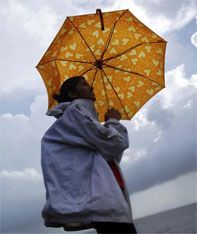Kharif sowing till June 20 almost 18 per cent less than last year; 328 districts under watch, based on rains in the first 15 days
 The southwest monsoon has covered almost half of India but pockets of worry remain. Of the 600-odd districts, 328 were under watch, based on the rainfall in the first 15 days, officials said.
The southwest monsoon has covered almost half of India but pockets of worry remain. Of the 600-odd districts, 328 were under watch, based on the rainfall in the first 15 days, officials said.
Rain was 45 per cent below normal for the week ended June 18, showed data from India Meteorological Department, the worst performance since 2009, when it was also 45 per cent below normal for this period. In the four months of monsoon in 2009, India saw almost 22 per cent deficiency in rain.
“As of now, there is no cause for worry and as the rain progresses to cover almost all of India, more and more districts will move to the normal list from the ‘watch’ list,” said a senior official from the department of agriculture.
He, however, warned the 328 districts could face difficulty if the monsoon took a break of over 15-20 days. For, the initial rainfall in the first fortnight of June in these areas wasn’t encouraging.
“The reason why we are not yet terming the overall situation as worrisome is that barring rainfall, the other two main indicators to declare an agriculture drought — surface moisture index and vegetation spread index —have not worsened,” the official said.
The districts under watch include 45 of 48 in Madhya Pradesh, 69 of 80 in Uttar Pradesh, all 25 in Gujarat, 24 of 35 in Maharashtra, all 25 in Rajasthan and 14 of 27 in Karnataka. The southwest monsoon arrived in India on June 6, five days behind its normal date. It had covered almost 50 per cent of the country till Thursday, late by four days.
The impact of the delayed onset and progress was being felt on sowing. Till Friday, the area covered under kharif crops was around 2.1 million hectares less than last year, the worst impact being on coarse cereals and rice. Data from the department of agriculture showed crops had been planted on 9.55 million hectares, down from 11.60 million hectares during the corresponding period last year.
Officials said rains could pick up and cover the central, western and northwest parts in the next week to 10 days. “Rainfall has increased in some parts of the central region but the monsoon continued to be weak,” a Reuters report said, quoting a weather official.
If there was no tangible change in the situation till the end of July or early August, a drought would be declared in those areas, the official said.
Water storage in 85 major reservoirs in the country is close to last year’s levels, except for the western and southern parts of the country, where it is below last year’s. Data from the Central Water Commission show live storage as on June 19 was 37.677 billion cubic metres, about 24 per cent of total live storage capacity of these reservoirs. This is 103 per cent of the storage in the corresponding period of last year and 152 per cent of storage of the past 10 years’ average.












 © 2025
© 2025